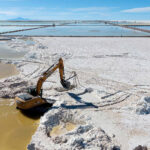Tracker 2.0: Rogue Press Officers
In January, The Astronomical Journal published a study suggesting that a planet the size of Neptune could be orbiting the sun beyond Pluto. The study’s authors had not seen it directly, but they inferred its presence from what appeared to be the push-and-pull of a large planet’s gravitational field on other objects. If they are right, this would be a new Planet 9 — a designation that once belonged to Pluto before it was demoted to a dwarf planet a decade ago. This was very big news.
![]() The California Institute of Technology, where the paper’s authors work, sent science journalists a press release describing the finding, and allowed them to interview the researchers on the condition that the reporters not publish the news until the study’s Jan. 20 publication. The idea of such news embargoes, as they are called, is to give reporters time to contact researchers, arrange for comment from outside experts, and prepare a careful story.
The California Institute of Technology, where the paper’s authors work, sent science journalists a press release describing the finding, and allowed them to interview the researchers on the condition that the reporters not publish the news until the study’s Jan. 20 publication. The idea of such news embargoes, as they are called, is to give reporters time to contact researchers, arrange for comment from outside experts, and prepare a careful story.
This is all standard operating procedure, except for one thing: According to BBC science correspondent Pallab Ghosh, Caltech granted this information and access to only 12 pre-selected reporters. The school won’t identify them, but Scientific American, The Washington Post, Science, and Popular Science were among publications that produced stories on Jan. 20 with comments from one or both of the study’s authors, suggesting they had the early access.
“Apart from the chosen 12, those working to news deadlines were denied the opportunity to speak to the researchers, obtain independent viewpoints or have time to properly digest the published research paper,” Ghosh wrote on the website of the World Federation of Science Journalists, a professional association of which he once served as president.
The news was too big to ignore or to delay, and Ghosh and other science reporters had to race to catch up to their competitors, publishing their stories with little time to read the study and without access to its authors.
Too bad for Ghosh, you might say. But this isn’t simply about journalistic competition. It’s also about readers. The inevitable result of Caltech’s selective release was “a scramble for the story,” Ghosh wrote, “which made it impossible for the reporting to be as good as we would all have wished, disadvantaging the interested public as well as science journalists themselves.”
Why do I bring this up? Because it’s the kind of thing that I and a few other reporters often discussed on the Knight Science Journalism Tracker blog, a daily critique of science writing that was launched in 2006 under the umbrella of the Knight Science Journalism program at MIT. The Tracker ran for eight years before it went on hiatus at the end of December 2014, with a promise that it would return in a new and better format.
With this column, we’re pleased to announce that The Tracker — along with its complete archives — is back online.
Tracker 2.0, now a column wearing fancier clothes and appearing at least monthly, will continue to turn a discerning eye on science journalism — the good, the bad, and the occasionally mystifying — with the hope that our analyses will help to keep science writing vibrant, alive, and free from temptation. We will monitor the business side of science journalism, shed light on the role of public information offices in distributing news to consumers (or not), and deconstruct how some of our era’s biggest, most complex stories are being told — a province where we sometimes expect to be as concerned about what isn’t reported as what is.
Like Undark, The Tracker’s new home, we will aim to explore science and science writing as “a frequently wondrous, sometimes contentious, and occasionally troubling byproduct of human culture.”
With that in mind, I took up Ghosh’s complaint with the public relations office at Caltech. I asked why it had chosen, in this case, to favor some reporters over others. Deborah Williams-Hedges, the contact on the press release, replied, “Thank you for your inquiry. We will not be offering comment on this topic.”
Ironic, coming from a press officer whose role it is to speak to the press.
I tried again. The second time I got a note from Farnaz Khadem, who joined Caltech Jan. 11 as its new chief communications officer. She wrote that the decision to share the news with only a chosen few was made before she arrived, but that she is committed “to working with the journalism community to ensure that our decisions regarding how and when we share such news are fair and transparent.”
Khadem didn’t explain what happened, and she didn’t apologize. But she did promise to do better. Perhaps the next time big news breaks out of Caltech, Ghosh and others will get the news at the same time as Caltech’s chosen 12.
The Caltech incident wasn’t the only public information disaster in recent weeks. In December, the University of Maryland issued a press release entitled, “Concussion-Related Measures Improved in High School Football Players Who Drank New Chocolate Milk, UMD Study Shows.”
The release landed in the middle of a national debate over American football and its role in contributing to brain damage among players — particularly those of high school-age. The idea that harm could be averted by something as simple as chocolate milk seemed like a dream solution — and a great story, if true.
It wasn’t. And it quickly fell apart under the scrutiny of skilled reporters.
One of the first to look into it was the journalist Andrew Holtz at HealthNewsReview.org. He noted that while the headline implied merely an association between milk and concussions, the initial paragraphs of the release went even further, claiming not just an association, but stating flatly that chocolate milk “helped high school football players improve their cognitive and motor function … even after experiencing concussions.”
When Holtz tried to look up the study the release was based on, he discovered that no study had been cited. Nor could he find it on the medical research site PubMed or on the University of Maryland’s website. Holtz had brief contact with the university, but then his requests for more information went unanswered. The school has since announced that it is mounting “an institutional review” of the matter.
He and Earle Holland, a former Ohio State University public information executive now also writing at HealthNewsReview.org, have not given up. “Earle is continuing to press UMD for details about their internal review,” Holtz told me. “I’m contacting others to find out what I can about the conduct of the study, including questions about whether the parents of the high school football players gave consent.”
It won’t be easy. Maryland’s chief communications officer, Crystal Brown, has been as communication-shy as Caltech’s Williams-Hedges. “Thanks for your interest in an interview, but I must respectfully decline at this time,” she said in an email to Holtz. “However, I’m happy to talk with you once a paper is published on this research and there is more conclusive information to share.”
If such a conclusion remains elusive, why did the university issue a release at all? The university has now inserted an “update” at the top of the online version of the release, which says: “This press release refers to study results that are preliminary and have not been subjected to the peer review scientific process.”
I later sent Brown an email to see whether she had anything to add. She told me about the update and sent me a link to the release. I emailed again, saying “So no plans to change it or remove it, and you stand by it?”
“We currently have no plans to take the release down,” she wrote back.
Something worth noting in all of this is that the magical protective properties described in the release were attached not to any chocolate milk, but only to Fifth Quarter Fresh, a high-protein chocolate milk developed at the University of Maryland, through the Maryland Industrial Partnerships Program, which funds research collaborations between Maryland companies and university faculty. This was, in other words, far from an independent study. The company that makes the product was involved in the research, raising questions about the impartiality — and legitimacy — of the claims.
The university might do better to drop its “institutional review” of the matter, retract the release, and admit that it made a mistake.
Stories such as these from Caltech and Maryland illustrate the importance of watchdog journalism. The Tracker will seek to perform that function for science writing itself —something we consider a high calling.
In my farewell post at the original incarnation of The Tracker, I wrote that journalists must “hold on to the values and principles that are the foundation of science journalism,” and that “the most important of those principles is that journalists’ allegiance should be exclusively to their readers.”
If they sacrifice that bond, they lose their credibility. Readers will no longer trust them. And when that happens, they’ve lost everything.
This article has been updated to refine the frequency with which the Tracker column will appear.










